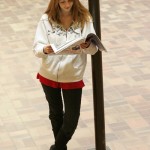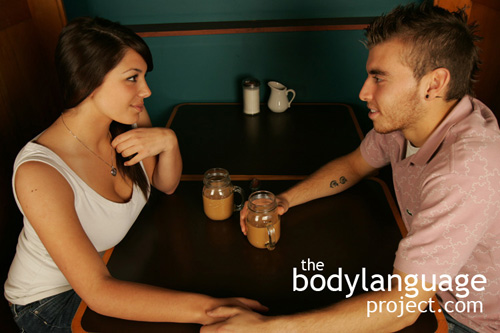As we have seen liars are difficult to detect and sometimes body language is more of a distraction than a help, however, as mentioned throughout, most people still rely on visual cues and identify (at least in their mind) liars through their body language. While these cues are only sometimes useful in detecting lies, they are always valuable as cues to avoid if the desire is to appear honest and trustworthy in the eyes of others. In other words, here is a list of cues to avoid emitting yourself!
Tag Archive for Distraction
Displacement Behaviours Protect Us In Public
by Chris Site Author • March 6, 2013 • 0 Comments

Stroking an object or “object caress” (context specific) can be a way to sooth a person when in public. In a courtship setting, an object caress spells interest.
Immediately upon leaving our homes, the place where we feel most comfortable, we begin to exhibit what is called “displacement behaviour”. Displacement behaviour is a coping mechanism that helps protect us emotionally from the outside world. The citizens of New York and other busy cities make for classic examples as they work their way through the city streets expressionless. The rest of the world sees these people as rude, despondent, miserable or unhappy but in actual fact it is completely normal and even constructive. Our public body language shifts subtly the moment we leave the door. Our faces show less emotion, it becomes more ‘pan faced’ as we if hiding our thoughts and inner feelings from others. City slickers immediately identify country folk. They make eye contact with strangers more often, and might even issue smiles, and nods at others, that is if they aren’t completely overtaken by fear and distraction. Making contact with others is normal for country folk. They come from an area where they know most of the inhabitants and therefore don’t fear public social interactions. Displacement behaviour is a stone-age protective mechanism. In our evolutionary past, had we encountered a group of strangers or a “city” of strangers, it would be in our best interest to internalize our fears and emotions so as not to betray our position. Our position is naturally fearful due in large part to being vastly outnumbered by what could be a potentially violent clan. We also wouldn’t want others to know that we carried valuable trade items, or were weak or scared. Therefore, our faces show a default position; no emotion.

Burying yourself in a book or listening to music through headphones are two great ways to retreat from the public eye so as to go unnoticed.
Displacement behaviours also show that we aren’t interested in interacting with others. You can test this for yourself by approaching people on the street looking for directions, for example. When you approach them it will take a second for them to snap out of their trance, if at all, before they notice that you are talking to them. They might even ask you to repeat what you have said because their mind had been “switched off”. Sometimes they even refuse to snap out of the trance at all and simply shake their head in a “no” type fashion from side to side, before continuing. We know people are in this type of trance because their body language become more self-focused. We pull our arms and legs inward, our face will become defocused, seemingly looking through people, and our body motions will become more minimal so as to avoid drawing attention to us. We may even become completely immobile and take on protective postures.

Nail biting is an oral fixation that replaces thumb sucking and allows the body to burn off nervous energy.
Another version of displacement behaviour happens when our minds are preoccupied with an emotion. When our home life begins to bother us when at work, our faces become emotionless as our minds drift to this more immanent problem. Our bodies display this detachment in various ways. For example, we begin to remove imaginary lint, play with a watch or pen, look away or become distracted, repetitive tapping of the fingers or foot, avoiding eye contact, rubbing the hands together, pinching an eyelid, smoothing clothing, rotating a wedding ring, nail-biting, or sucking a finger or pen. These all indicate a hidden thought linked to anxiety. The word displacement, in this fashion indicates that one is trying to avoid the task or issue at hand, and is instead, busy themselves with an activity that is much less taxing. Another form of displacement behaviours include sitting slumped over, with a glazed look endlessly staring at the floor or a spot on the wall.
Sometimes displacement behaviours are used to avoid conflict with others and those taking part would rather not be in the situation. To avoid conflict, they appear busy and preoccupied by doing other things. Displacement behaviours can also include gum chewing or nail biting, grooming, tapping, head scratching or playing with jewelry. It includes any behaviour that is out of place and serves the purpose of removing one’s self from the situation or topic at hand. We all understand when someone tries to “change the subject”, this is the same thing, only it is accomplished silently.
Introduction – Chapter 5
by Chris Site Author • March 5, 2013 • 0 Comments
The language of the eye has been shown by researchers to be more reliable than other body language because the movements the eyes make are involuntary and fleeting. This makes it hard for people to pay as much attention to them as, say the arms, hands or the legs. Eyes straight ahead while considering an answer, as we will see means that a prospect is passively considering information, the eyes down means that someone is concentrating or evaluating and the eyes upward means that an idea is being analyzed. Conversely, eyes looking off into space indicates a loss of interest, and eye contact avoidance indicates submission or fear. We can also tell a lot about what a person is thinking just by how the eyes move and then relating it back to context as we shall cover later.
In the seventies, Michael Argyle found that about sixty percent of conversation involved some form of gazing. He found that only thirty percent involved mutual gazing where the eyes met and held eye contact directly and that people look twice as often (seventy-five percent) while listening, versus just forty percent while speaking. The average gaze length was recorded to be about three seconds long whereas mutual gaze lasted just over one second before being broken. Eye contact has been found to be related to both cultural and personality differences. For example, Japanese and South Americans use far less eye contact as it is thought to be aggressive and disrespectful and introverted people make less eye contact then someone who is extroverted. It has also been shown through research that eye gaze is an indication of patterns in speech. People will tend to look away as they begin to speak, presumably to avoid distraction, and will then return their gaze as they near completion of their thought.
Eye contact is also a great way to measure like-mindedness. The more agreement is formed between individuals, the more eye contact is present. Even under research conditions where strangers were forced to hold eye contact for extended periods of time, they reported a greater sense of liking. We also tend to distrust others who make poor eye contact with us because subconsciously we think they are trying to hide something. The following chapter deals with the complete language of the eyes including its hidden meaning.

